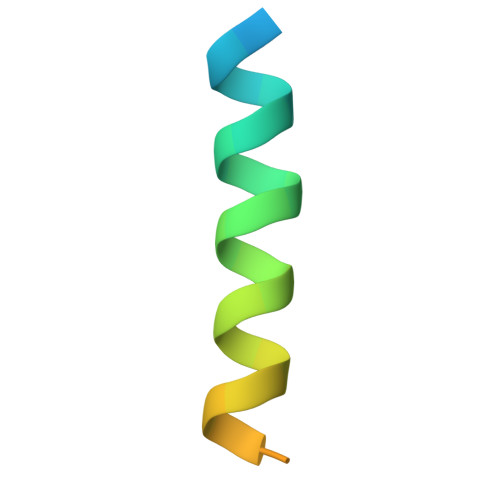Three-Dimensional Structure of the Transmembrane Domain of Vpu from HIV-1 in Aligned Phospholipid Bicelles.
Park, S.H., De Angelis, A.A., Nevzorov, A.A., Wu, C.H., Opella, S.J.(2006) Biophys J 91: 3032-3042
- PubMed: 16861273
- DOI: https://doi.org/10.1529/biophysj.106.087106
- Primary Citation of Related Structures:
2GOF, 2GOH - PubMed Abstract:
The three-dimensional backbone structure of the transmembrane domain of Vpu from HIV-1 was determined by solid-state NMR spectroscopy in two magnetically-aligned phospholipid bilayer environments (bicelles) that differed in their hydrophobic thickness. Isotopically labeled samples of Vpu(2-30+), a 36-residue polypeptide containing residues 2-30 from the N-terminus of Vpu, were incorporated into large (q = 3.2 or 3.0) phospholipid bicelles composed of long-chain ether-linked lipids (14-O-PC or 16-O-PC) and short-chain lipids (6-O-PC). The protein-containing bicelles are aligned in the static magnetic field of the NMR spectrometer. Wheel-like patterns of resonances characteristic of tilted transmembrane helices were observed in two-dimensional (1)H/(15)N PISEMA spectra of uniformly (15)N-labeled Vpu(2-30+) obtained on bicelle samples with their bilayer normals aligned perpendicular or parallel to the direction of the magnetic field. The NMR experiments were performed at a (1)H resonance frequency of 900 MHz, and this resulted in improved data compared to lower-resonance frequencies. Analysis of the polarity-index slant-angle wheels and dipolar waves demonstrates the presence of a transmembrane alpha-helix spanning residues 8-25 in both 14-O-PC and 16-O-PC bicelles, which is consistent with results obtained previously in micelles by solution NMR and mechanically aligned lipid bilayers by solid-state NMR. The three-dimensional backbone structures were obtained by structural fitting to the orientation-dependent (15)N chemical shift and (1)H-(15)N dipolar coupling frequencies. Tilt angles of 30 degrees and 21 degrees are observed in 14-O-PC and 16-O-PC bicelles, respectively, which are consistent with the values previously determined for the same polypeptide in mechanically-aligned DMPC and DOPC bilayers. The difference in tilt angle in C14 and C16 bilayer environments is also consistent with previous results indicating that the transmembrane helix of Vpu responds to hydrophobic mismatch by changing its tilt angle. The kink found in the middle of the helix in the longer-chain C18 bilayers aligned on glass plates was not found in either of these shorter-chain (C14 or C16) bilayers.
Organizational Affiliation:
Department of Chemistry and Biochemistry, University of California at San Diego, La Jolla, California 92093-0307, USA.














